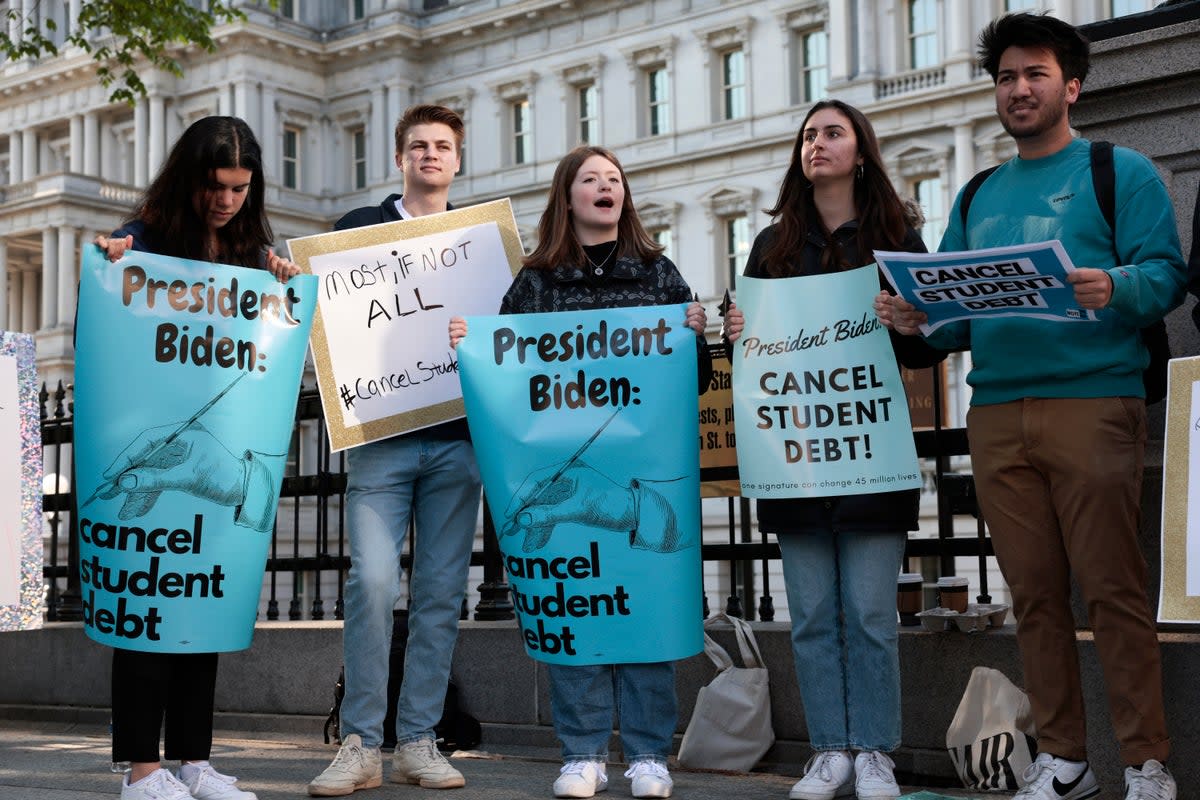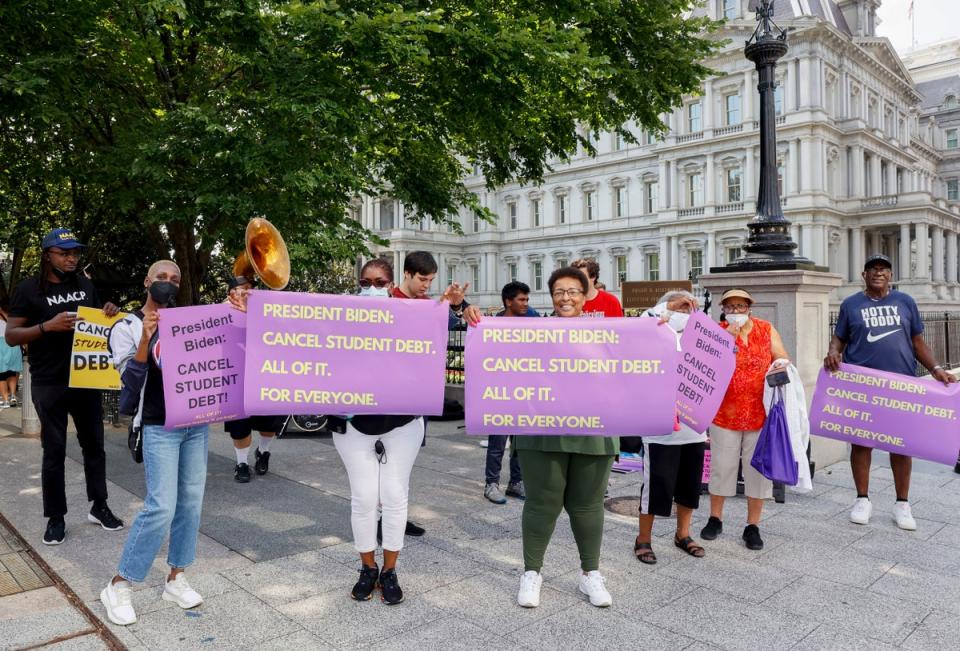Biden is canceling $10,000 in student loan debt. Advocates urge him to cancel it all

- Oops!Something went wrong.Please try again later.
More than two years after his campaign-trail promise to cancel $10,000 in student loan debt per borrower, President Joe Biden is making good on his pledge to provide relief.
In November 2020, weeks before he entered the White House, the president called on Congress to “immediately” provide some relief for millions of borrowers saddled by growing debt.
“[Student debt is] holding people up,” he said at the time. “They’re in real trouble. They’re having to make choices between paying their student loan and paying the rent.”
On 24 August, less than a week before a Covid-19 pandemic-era moratorium on monthly payments and interest is set to expire, the administration extended the pause until 31 December, granting a lifeline to millions of borrowers who would otherwise be forced to resume payments on 1 September, prolonging a growing crisis after more than two years of relief.
The administration announced a move to cancel $10,000 in federal loan debt for borrowers with an annual income of up to $125,0000. Pell Grant recipients are eligible for up to $20,000 in relief. Debt relief advocates have urged the president to cancel it all, with the stroke of a pen.
Since March 2020, with congressional passage of the CARES Act, most federal student loan borrowers have been able to pause their monthly payments with interest rates set at zero per cent. That pause has been extended seven times, including four times by President Biden, most recently in April.
More than 40 million Americans hold roughly $1.9 trillion in student loan debt, most of which is wrapped up in federally backed loans. The average balance is $37,667, according to the Education Data Initiative.
Canceling $10,000 in debt for people who took out federal student loans would settle the balances for roughly one third of borrowers, and halve the balances of another 21 per cent, according to the US Department of Education.
But advocates have argued that means-testing a broad-based loan forgiveness plan by setting an income cap or other requirement would leave millions of borrowers on the hook for tens of thousands of dollars in debt.
“We’re not fighting for anything less,” Student Debt Crisis Center outreach director Sabrina Calazans told The Independent. “If he promised that, that’s why we have to hold him accountable.”
A growing crisis
The amount of debt taken out to support student loans for higher education costs has ballooned within the last decade while tuition spiked, private university enrollment grew and governments stripped investments in higher education budgets, putting the burden of costs on students and their families.
Meanwhile, federal policy changes effectively eliminated limits on borrowing, and predatory lending schemes and sky-high interest rates have trapped generations of borrowers into a lifetime of debt.

Borrowers who spoke with The Independent over the last two years of the pandemic-era repayment pause have said their debt balance and interest rates have effectively held their financial lives hostage, all in the name of pursuing a degree, some of which were earned more than a decade ago, with the promise of better employment opportunities and wages to pay it off.
But most loan debt issued today will never be paid off. Borrowers are increasingly not making any progress toward paying off their loans, with interest adding to balances that exceed the original loan, while the pandemic pause has been a lifeline for millions of borrowers.
Over the weekend, Education Secretary Miguel Cardona told NBC’s Meet The Press that a decision from the administration on student debt was due within the week.
“What I hear from people each day is that they’re extremely concerned, they’re anxious, they’re stressed, they’re worried,” Ms Calazans told The Independent. “[The expiration of the moratorium] is less than one paycheck away. For people who are paid bi-weekly, they don’t have another paycheck coming in before those payments resume. … Are they going to be able to afford child care? Can they pay their rents? Can they afford medication?”
A statement to The Independent from a spokesperson for Education Department said the agency “will continue to assess the impacts of the Covid-19 pandemic and the economy on student loan borrowers” and will “communicate directly with borrowers about the end of the payment pause when a decision is made.”
Student debt is a nearly $2,000,000,000,000 crisis. @POTUS must #CancelStudentDebt. All of it. https://t.co/4OkmgsPSsj
— Cori Bush (@CoriBush) August 23, 2022
Ms Calazans was among a group of borrowers that met with Mr Cardona along with Senators Chuck Schumer and Elizabeth Warren in April 2021 – thus far the highest-level meeting between borrowers and the Biden administration – as the Education Department mulled whether the president has legal authority to unilaterally cancel student debt through executive action.
A subsequent memo was not publicly released, and the White House has reportedly been at odds about relief actions as it approached several expiration dates. Publicly, the administration has said the president supports legislation from Congress to cancel debts, a nonstarter in a dead-locked Senate.
President Biden should #CancelStudentDebt to: help narrow the racial wealth gap among borrowers, provide relief to the 40% of borrowers who never got to finish their degree, and give working families the chance to buy their first home or save for retirement. It’s the right thing.
— Elizabeth Warren (@SenWarren) August 23, 2022
Meanwhile, in the months between announcements to extend the repayment pause, borrowers continued to receive dozens of emails reminding them about their impending repayments, while advocates and progressive lawmakers urged the administration to make that relief permanent.
NAACP president Derrick Johnson, who also joined that White House meeting, said in a statement that “canceling $10,000 in student loan debt is like pouring a bucket of ice water on a forest fire.”
Mr Johnson pointed to the disproportionately heavy debt burden among Black borrowers, who owe an average of $25,000 more in student loan debt than white college graduates, according to the Education Data Initiative.
“The Black community will be watching closely when you make your announcement, but $10,000 is not enough,” Mr Johnson said. “$10,000 is a slap in the face.”
‘People are going to have to start making some really tough decisions’
Before the pause was extended earlier this year, nine out of 10 borrowers said they would not be financially stable by 1 February to begin repayment, according to a survey of 33,000 borrowers conducted by the Student Debt Crisis Center.
A Government Accountability Office report in January also signaled that as many as half of borrowers with federal loans were at risk of falling behind on their payments when the moratorium expires.
Without immediate relief, “I think people are going to have to start making some really tough decisions,” Ms Calazans told The Independent.
“I think it’s very easy for us to dismiss the pandemic and the lingering effects, but people are still very much living with those effects today – whether it’s reduced work hours, losing jobs, or having to leave the workforce, as many women have had to do in order to take care of their children,” she said.
A recent report from left-wing think tank the Roosevelt Institute also has countered criticism that student debt relief would drive inflation and “wipe out” the progress of the recently enacted Inflation Reduction Act.
“It is imperative that policymakers work on reducing inflation, and we’ve proposed a whole-of-government approach to doing so,” according to the report. “But battling inflation should not preclude the Biden administration from addressing the other economic pressures and inequities Americans are facing.”
The more student debt you cancel, the more you narrow the racial wealth gap.
The more student debt you cancel, the more you boost the economy.
The more student debt you cancel, the better chance Democrats have in the midterms.— The Debt Collective 🟥 (@StrikeDebt) August 22, 2022
The administration already has canceled roughly $32bn in student debt, mostly impacting students defrauded by discredited colleges.
In June, the administration canceled nearly $6bn for 560,000 borrowers who attended schools affiliated with Corinthian Colleges, marking the single-largest discharge of student loan debt in the Education Department’s history.
Last week, the administration canceled the remaining federal student loan debt for roughly 208,000 students who attended ITT Technical Institute, amounting to nearly $4bn in relief, after the Education Department found that the for-profit college “engaged in widespread and pervasive misrepresentations.”
Sweeping debt relief impacting those students follows years of organising from debt relief advocates who joined strike campaigns refusing to make payments on their loans, backed by a growing movement fighting back against predatory loan programmes and pushing the Biden administration to eliminate debts.
ITT Tech borrowers who took part in that debt strike “were told they were crazy and that they should shut up and pay their loans,” according to Ann Larson, co-founder of debt relief organisation the Debt Collective.
“They kept fighting through three presidential administrations,” she told The Los Angeles Times. “And now everyone knows they were right all along.”
This piece was originally published on 23 August and has been updated

